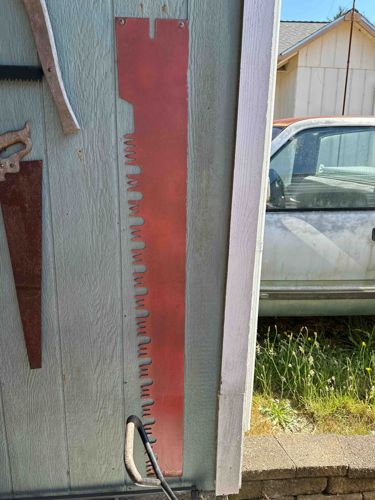
Vintage One-Person Crosscut Saw Blade
The item depicted is a vintage one-person crosscut saw blade, likely dating from the early to mid-20th century. It is constructed from a substantial piece of steel, exhibiting a reddish-brown hue characteristic of rust or a protective coating commonly found on older tools. The blade is long and relatively narrow, designed for cutting across the grain of wood. One long edge features a series of sharply pointed teeth, exhibiting a 'peg tooth' or 'M-tooth' pattern, commonly used for efficient cutting through timber. The tines appear consistently sized and shaped along the length of the blade, though some minor wear or dulling might be present given its age. The opposing edge is straight. At the top end, there's a distinct, large slot or notch cut into the blade, which would have been used to attach a handle, often a D-handle, for a single user. There are also two visible small holes near the top, indicating points for fasteners to secure the handle. The blade shows significant signs of age and outdoor exposure, with a pervasive rust patina across its surface. No clear maker's marks or signatures are discernible from the image, which is common for older tools unless specifically sought out and cleaned. Its primary use would have been felling trees or bucking logs. The craftsmanship appears robust, indicative of tools made for heavy, manual labor. The absence of a handle and the condition suggest it is either a display piece or requires restoration for functional use.
AI-Generated Appraisal Disclaimer
Estimated Value
$40-75
Basic Information
Category
Woodworking Tool
Appraised On
December 5, 2025
Estimated Value
$40-75
Item Description
The item depicted is a vintage one-person crosscut saw blade, likely dating from the early to mid-20th century. It is constructed from a substantial piece of steel, exhibiting a reddish-brown hue characteristic of rust or a protective coating commonly found on older tools. The blade is long and relatively narrow, designed for cutting across the grain of wood. One long edge features a series of sharply pointed teeth, exhibiting a 'peg tooth' or 'M-tooth' pattern, commonly used for efficient cutting through timber. The tines appear consistently sized and shaped along the length of the blade, though some minor wear or dulling might be present given its age. The opposing edge is straight. At the top end, there's a distinct, large slot or notch cut into the blade, which would have been used to attach a handle, often a D-handle, for a single user. There are also two visible small holes near the top, indicating points for fasteners to secure the handle. The blade shows significant signs of age and outdoor exposure, with a pervasive rust patina across its surface. No clear maker's marks or signatures are discernible from the image, which is common for older tools unless specifically sought out and cleaned. Its primary use would have been felling trees or bucking logs. The craftsmanship appears robust, indicative of tools made for heavy, manual labor. The absence of a handle and the condition suggest it is either a display piece or requires restoration for functional use.
Get Your Items Appraised
Instant estimates of your treasures with AI-powered instant appraisals